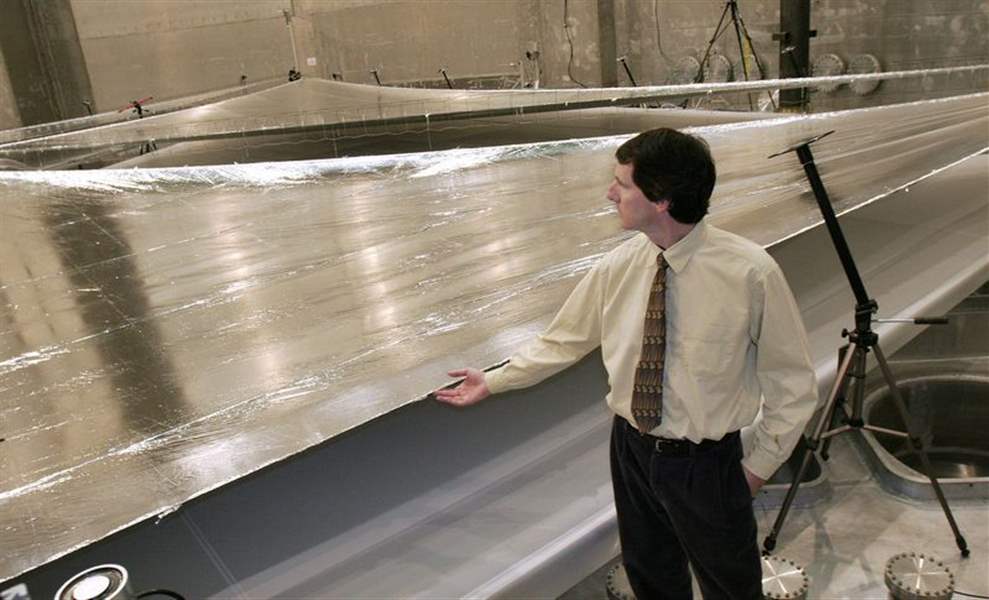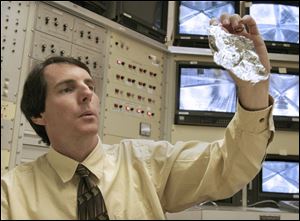
Sandusky facility puts space kite through its paces
4/28/2005
Dave Murphy, principal investigator for ATK Space Systems, ripples the surface of a solar sail panel at the NASA Glenn Research Center's Plum Brook Station in Sandusky.
zapotosky / blade

Dave Murphy, principal investigator for ATK Space Systems, ripples the surface of a solar sail panel at the NASA Glenn Research Center's Plum Brook Station in Sandusky.
SANDUSKY - The silvery sheet shimmered and undulated like a pool of mercury, its fabric so thin, a human hair would be a massive column beside it, some 50 times thicker.
This could be the future of space travel - a gossamer kite that sails on light. At the NASA Glenn Research Center's Plum Brook Station, a solar sail is undergoing a battery of tests in the world's largest vacuum chamber - a soaring cylinder of aluminum wrapped in 8-foot-thick concrete walls, 122 feet tall, and 100 feet in diameter.
If the sail passes its tests, it could become the model for a new kind of space propulsion, a sheet that will harness not the power of wind, but the gentle, continuous stream of sunlight.
On Earth, we aren't aware of the photons - subatomic particles of light - that bombard us every moment. Compared to the force of gravity, or the gentle flow of air currents eddying in a closed room, photon force is beyond delicate. It hasn't the power to tickle a tissue.
But in the vacuum of space, where neither gravity nor wind interferes, photons become a force to harness.
A sail can take advantage of the photon pounding, increasing the force of each photon strike by reflecting the light packet back from an aluminized surface.

Mr. Murphy examines a section of the solar sail. ATK is one of two solar sail companies competing to win NASA's favor.
"This wasn't possible a decade or two ago," said Edward Montgomery, technology manager of Solar Sail Propulsion at Marshall Space Flight Center in Huntsville, Ala., on hand yesterday at the Sandusky test site.
The lightweight-yet-durable material that makes the sail - a type of polymer - had not been invented. It arose from a happy accident that occurred in laboratories investigating new paints for spacecraft, he said. The polymer is coated with a layer of bright aluminum 800 millionths of a hair's breadth. The graphite-composite material that forms the four masts of the solar sail also is a recent development.
Two companies, ATK Space Systems of Goleta, Calif., and L'Garde Inc. of Tustin, Calif., are competing to win the favor of the National Aeronautics and Space Administration to create sails that can be used in interplanetary exploration with unmanned spacecraft in the $30 million developmental program.
The sail under testing this month at Plum Brook is made by ATK. L'Garde will come to Plum Brook to test its sail in June.
The sail material itself has been tested for its vulnerability to tiny meteorites. Tests thus far show such objects in space will leave a hole, but not create a tear, and have no impact on the sail's efficiency.
Solar sails could allow small, unmanned craft to travel as long as the sail survives without the prohibitive weight of conventional fuels.
The sail is light, although 66 feet on each side. "You could lift it with one hand," said Dave Murphy, the principal investigator for ATK.
Well, maybe not everyone could lift it with one hand, but the entire unit, including the sail and the center unit it is packed in, weigh about 50 pounds.
The Plum Brook facility is preparing for about two weeks of testing the sail under vacuum conditions.
It takes roughly eight hours to create a vacuum within the giant cylinder, where the sail will be tested under a variety of temperatures and stresses.
While the sail, which is made up of four triangular quadrants, sags under the weight of gravity, in space, it will be as flat as a well-made bed.
Spacecraft using solar sails will require conventional rockets to reach orbital height. But once in space, the ATK sail coils out four giant masts from a central unit, making a giant metal X. When the masts reach their full extent, and are tested, the sail is fed out gradually until a corner of each triangular sections is anchored to the tip of a mast.
In flight, direction is controlled by twisting at the boom ends, which morphs the sail shape, or by the movement of weights along the length of each of the four masts.
Les Johnson, manager of space propulsion research projects at the Marshall center, said NASA probably won't begin using space sails until the next decade.
But a private group is planning to test a space sail-powered craft later this year.
The Planetary Society, with headquarters in Pasadena, Calif., could launch a test vehicle at the end of May. The vehicle, called Cosmos 1, is being built in Russia and will be launched from a submarine and ultimately powered by a mylar-like sail for a flight that may last anywhere from a few days to a few weeks, said Louis Friedman, president of the Planetary Society.
While NASA isn't directly involved in that project, it is following its progress.
"We're going to look at their data, absolutely," Mr. Johnson said. "It's a technology whose time has come," he said.
Contact Jenni Laidman at:
jlaidman@theblade.com
or 419-724-6507.